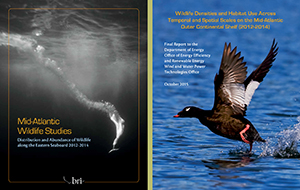Mid-Atlantic Baseline Studies (MABS)
The goal of the Mid-Atlantic Baseline Studies (MABS) Project was to provide comprehensive baseline ecological data and associated predictive models and maps to regulators, developers, and other stakeholders for offshore wind energy. This knowledge on wildlife distributions, movements, and habitat use will help inform the siting and permitting of offshore wind facilities on the mid-Atlantic Outer Continental Shelf.
Lead Investigator: Kate Williams

Download Mid-Atlantic Wildlife Studies: Distribution and Abundance of Wildlife along the Eastern Seaboard 2012-2014. This 32-page summary publication explores aspects of the mid-Atlantic ecosystem; describes our survey and analytical approaches; and presents a range of results, featuring several case studies on specific species or phenomena.
The Executive Summary for the technical report is also available here.
Significant both ecologically and economically, the mid-Atlantic region is used by a broad range of marine wildlife species across the entire annual cycle, including several dozen species listed as threatened or endangered at the federal level or state level. The importance of the region for these wildlife species is due, in part, to the region’s central location in a major migratory flyway and a relatively high level of primary productivity (growth of phytoplankton).
The Mid-Atlantic Baseline Studies project focused on a broad swath of Outer Continental Shelf waters (an area of 13,245 square kilometers) off the coasts of Delaware, Maryland, and Virginia. We used several study methods to document animal distributions, abundance, movements, and habitat use:
- Boat-based and digital video aerial surveys each had specific advantages and disadvantages, but were largely complementary. Digital aerial surveys may be particularly useful for covering offshore areas at broad scales, where general distributions of taxonomic groups are a priority; boat surveys can provide more detailed data on species identities and behaviors, but are more limited in geographic scope due to their slower survey pace. Detailed results on our comparisons between the two study methods can be found here and in our full report.
- Habitat gradients in nearshore waters were important influences on productivity and patterns of species distributions and abundance. Areas offshore of the mouths of Chesapeake and Delaware Bays, as well as to the south of Delaware Bay along the coast, were consistent hotspots of abundance and species diversity, regardless of survey methodology or analytical approach.
- The study area was important for wintering and breeding taxa, and its location also made it a key migratory corridor. There was considerable variation in species composition and spatial patterns by season, largely driven by dynamic environmental conditions
Case Studies
We present several case studies on specific taxa or phenomena. Each case study includes the integration of data from multiple study components, presenting a comprehensive view of wildlife distribution and movement patterns. These case studies include:
This baseline assessment focused on understanding the potential exposure of wildlife to future offshore development. The results of this study offer insight to help address environmental permitting requirements for current and future projects. These data serve as a starting point for more site-specific studies, risk analyses, and evaluation of potential measures to avoid and minimize risks to wildlife from human activity in the offshore environment.
Project Team and Funding
This work was supported by the Department of Energy Wind and Water Power Technologies Office under Award Number DE-EE0005362.
Lead and Co-Primary Investigators and Partners: Evan Adams, David Evers, Andrew Gilbert, Iain Stenhouse, Kate Williams (BRI); Richard Veit (City University of New York); Beth Gardner, Holly Goyert, Nathan Hostetter, Rahel Sollmann (North Carolina State University); David Johnston and Logan Pallin (Duke University); Ari Friedlaender (Oregon State University); Phillip Chilson (University of Oklahoma)
Contributing BRI Staff: Emily Connelly, Chris DeSorbo, Melissa Duron, Wing Goodale, Carrie Gray, Rick Gray, Sarah Johnson, Robby Lambert, Dustin Meattey, Lucas Savoy
Collaborators: Particular project components were completed in collaboration with one or more of the following organizations: HiDef Aerial Surveying, Ltd., Capt. Brian Patteson, USGS Patuxent Wildlife Research Center, Memorial University of Newfoundland, Canadian Wildlife Service, U.S. Fish and Wildlife Service, Sea Duck Joint Venture, Virginia Department of Game and Fisheries, Delaware Division of Fish and Wildlife, Rhode Island Division of Fish and Wildlife, University of Rhode Island, Oregon State University, North Carolina Wildlife Resource Commission.
Funding: Additional funding support for certain project components came from the Maryland Department of Natural Resources and the Maryland Energy Administration (under Contract Number 14-13-1653 MEA), the Bureau of Ocean Energy Management, U.S. Fish and Wildlife Service, Sea Duck Joint Venture, The Bailey Wildlife Foundation, The Nature Conservancy, The Ocean View Foundation, The Bluestone Foundation, Memorial University of Newfoundland, Maine Outdoor Heritage Fund, the Davis Conservation Foundation, Biodiversity Research Institute, and other source
Please refer to the final report for the Mid-Atlantic Baseline Studies project for more information.
Photo Credits: Photo Credits: Surf Scoter © BRI-Jonathan Fiely


